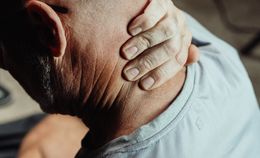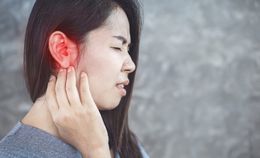There are many different types of pain and conditions where pain can be a symptom that is experienced - from fibromyalgia to MS.
Craniosacral therapy can be a beneficial therapy to help mange and alleviate pain.
Craniosacral Therapy for Pain
According to statistics available on the National Institute of Health (NIH) database, pain affects more Americans than cancer and heart disease combined. It is the reason why many people
access the health care system, and the primary cause of disability, a large percentage of the ever increasing health care costs.
Statistics from 2016 also revealed that approximately one in every four Americans, which is about 76.2 million people, suffered pain that lasted for more than 24 hours.
In addition, the Centers for Disease Control and Prevention (CDC) estimated in 2018 than 50 million Americans have chronic pain, and in 2017 that 57% of adults suffer back pain for longer than 5 years.
This number of Americans suffering from pain is very high, and you may be asking, "What is Craniosacral Therapy (CST), and how does it help deal with pain?"
What is Craniosacral Therapy?
CST was established by John Upledger in the 1970s as a branch of cranial osteopathy.
The term craniosacral is the fusion of two words: cranium (skull) and the sacrum. The sacrum is the pelvic bones that connect to the spine. Craniosacral Therapy is a process where the hands are used to evaluate and enhance the physiological system, called the craniosacral system.
This system comprises of the cerebrospinal fluid and membranes that surround and protect the spinal cord and brain. These components work in tandem for the general well being of the body. Therefore, if there is a blockage in the fluid, for instance, it can trigger issues throughout the body.
Practitioners use gentle touches to release blockages in the craniosacral system - which improves the functioning of the central nervous system. The release of restrictions is necessary even years after injuries have occurred in the body. Many injuries have lingering effects for years because the system was not rebalanced after the trauma.
How Craniosacral Therapy Can Work to Relieve Pain
The fluids and membranes surrounding the central nervous system undergo strains as you navigate your daily activities. This eventually leads to the formation of tension that restricts normal bodily functions. Craniosacral therapy (CST) is applied to ease this tension around the spinal cord and brain, bringing it back to its optimal state relieving pain and discomfort.
CST complements the body's natural healing process; and as a result, it helps boost resistance to diseases. It is also effective for many conditions associated with pain, discomfort, and dysfunction.
10 Craniosacral Therapy Techniques for Treating Pain
According to a clinical trial, there are ten craniosacral therapy techniques that are often used for treating pain:
-
Still Point (CV-4, Sacred Feet)
-
Diaphragms (pelvic, respiratory, thoracic inlet, hyoid, Occipital Cranial Base)
-
Decompression L5-S1
-
Dural Tube Glide
-
Lift Front
-
Parietal Lift
-
Compression/decompression of the joint sphenobasilar
-
Temporary Technique
-
Compression/decompression of the temporomandibular joints
-
Still Point CV-4
Craniosacral Therapy has a wide range of uses. It can be used to relieve stress, allowing your body to relax and self-heal. CST can alleviate neurological stress, injuries, concussions, headaches, and migraines. If you have suffered from past emotional or physical trauma, Craniosacral Therapy is a non-invasive process that will help your body resolve these tensions and emotions, and it will provide you with relief from pain.
12 Pain-Related Health Conditions Where Craniosacral Therapy Will Help
Here is a list of some health conditions:
-
Pelvic Pain
-
Post-Traumatic Stress Disorder
-
Neurovascular Disorders
-
Temporomandibular Joint Syndrome (TMJ)
-
Fibromyalgia
-
Stress/ Tension-Related Issues
-
Chronic Fatigue
-
Traumatic Brain and Spinal Cord Injuries
-
Concussions
-
Central Nervous System Disorders
-
Motor-Coordination Impairments
-
Headaches
Craniosacral Therapists use gentle touches to manipulate your body's rhythm to create healing blood flow. Most often, there will be a release of trapped traumas from physical injuries, or from emotional and psychological stress, throughout an individual's life.
If you have been told your condition is genetic or as a result of stress, and have unhappily learned to live with it, there might be hope if your condition is a result of blockages in circulation. Your chronic pain might continue with other treatments if the root cause of tensions around the central nervous system is not addressed.
This explains how craniosacral therapy works, and how it can be beneficial for pain in general.
Craniosacral Therapy can Help with Chronic and Acute Pain
According to a study published in the Journal of Pain Research, pain should be classified as a disease because of its enormous global burden of the condition. It suggests that recognizing pain as a pathological state will help raise awareness of this global health problem; as well as, trigger additional studies of specific therapeutic approaches to help combat this disease.
Chronic Pain
According to a study at Stanford University School of Medicine, Department of Anesthesia, chronic pain is a physical experience which lasts for more than 6 months.
Chronic pain is not the usual injuring a knee while running or cutting your finger which repairs over time. It is a constant, dull pain that refuses to heal often accompanied by stiffness, shooting, throbbing or burning sensations.
Chronic pain often develops when an injury is not taken care of properly. When you suffer an injury, pain sensors around the affected region send signals to the nerves in your brain. As the injury heals, the strength of the pain signals fade until you no longer feel anything. However, in chronic pain, the nerves continually send signals to the brain even after the body has fully recovered.
It is difficult to identify the source of one's chronic pain; therefore, many treatments are often trial and error. And when left unattended to, this discomfort can impair normal daily activities of the individual. The inability to carry out one's regular routine may lead to other mental health issues, as pain is interconnected with the feeling of fear, depression, anger, anxiety and many more.
7 Chronic Pain Conditions Craniosacral May Help
While finding the right treatment for chronic pain is difficult, it is not impossible. Listed below are regular causes of chronic pain. If you experience any of these, consider Craniosacral Therapy to manage and eliminate the pain:
-
Nerve Damage
-
Infections
-
Migraines
-
Arthritis
-
Past, untreated injuries
-
Neck problems
-
Back problems
Acute pain
Acute pain is triggered by a specific injury or disease, has a biological purpose, and is limited in scope. Chronic pain, on the other hand, outlasts the normal healing time. Therefore, it is a disease state that serves no biological purpose and has no endpoint.
Acute pain is related to soft tissues such as a scrape or sprain, and it goes through the normal cycle of wound healing which subsides when the injury heals. It usually comes as a sharp, severe discomfort and is easily addressed.
How Many Sessions Are Recommended?
The benefits of Craniosacral Therapy for pain can often be felt after one session. However, it is often suggested that 3-10 weekly, one hour sessions, will yield the best results in reducing levels of pain.
It should be noted, after a treatment plan has been completed, many find maintenance sessions help to maintain the progress that has been experienced through Craniosacral Therapy for pain.
In addition, communicating with your Craniosacral Therapy practitioner about the number of sessions to meet your health and wellness needs is always a good idea.
What Will Craniosacral Therapy for Pain Cost?
The average price per session in the United States is $70-$170.
If you find that the average three-to-ten sessions ends up serving your needs for managing your levels of pain, you can expect to pay $700 on the low end and $1,700 on the high end.
For more information, read: How Much Does Craniosacral Therapy Cost?
References:
Craniosacral Therapy to Treat Chronic Low Back Pain - Full-Text View. (n.d.). Retrieved April 24, 2019, from https://clinicaltrials.gov/ct2/show/NCT01822236
Grichnik, K. P., & Ferrante, F. M. (1991, May). The difference between acute and chronic pain. Retrieved April 24, 2019, from https://www.ncbi.nlm.nih.gov/pubmed/1875958
Health, United States, 2006 with Chartbook on Trends in ... (n.d.). Retrieved April 24, 2019, from https://www.cdc.gov/nchs/data/hus/hus06.pdf
NIH Fact Sheets - Pain Management. (n.d.). Retrieved April 24, 2019, from https://report.nih.gov/nihfactsheets/viewfactsheet.aspx?csid=57
Mataran-Penarrocha, G. A., Castro-Sanchez, A. M., Garcia, G. C., Moreno-Lorenzo, C., Carreno, T. P., & Zafra, M. D. (2011). Influence of craniosacral therapy on anxiety, depression, and quality of life in patients with fibromyalgia. Evidence-based complementary and alternative medicine : eCAM, 2011, 178769. doi:10.1093/ecam/nep125. Retrieved April 10, 2019, from https://www.ncbi.nlm.nih.gov/pmc/articles/PMC3135864/
Powell, W., 2nd, & Knaap, S. F. (2015). Cranial Treatment and Spinal Manipulation for a Patient With Low Back Pain: A Case Study. Journal of chiropractic medicine, 14(1), 57-61. doi:10.1016/j.jcm.2014.12.001. Retrieved April 10, 2019, from https://www.ncbi.nlm.nih.gov/pmc/articles/PMC4371110/
Upledger, J. E., Kaplan, B. S., Bourne, R. A., & Zonderman, R. B. (n.d.). THE EFFECTS OF UPLEDGER CRANIOSACRAL THERAPY ON POST TRAUMATIC STRESS DISORDER SYMPTOMATOLOGY IN VIETNAM COMBAT VETERANS. Retrieved April 24, 2019, from http://journals.sfu.ca/seemj/index.php/seemj/article/view/302
Wetzler, G., Roland, M., Fryer-Dietz, S., & Dettmann-Ahern, D. (2017). CranioSacral Therapy and Visceral Manipulation: A New Treatment Intervention for Concussion Recovery. Medical acupuncture, 29(4), 239-248. doi:10.1089/acu.2017.1222. Retrieved April 10, 2019, from https://www.ncbi.nlm.nih.gov/pmc/articles/PMC5580370/





















